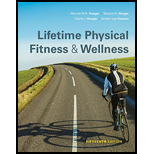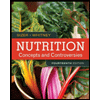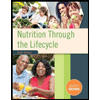
Lifetime Physical Fitness and Wellness
15th Edition
ISBN: 9781337392686
Author: Wener W.K. Hoeger, Sharon A. Hoeger, Cherie I Hoeger, Amber L. Fawson
Publisher: Cengage Learning
expand_more
expand_more
format_list_bulleted
Question
error_outline
This textbook solution is under construction.
Knowledge Booster
Learn more about
Need a deep-dive on the concept behind this application? Look no further. Learn more about this topic, health-nutrition and related others by exploring similar questions and additional content below.Similar questions
- Regarding fluid intake in school-age children, which of the following statements is most correct? a. Soft drinks are good choices for hydration during exercise because the high carbohydrate content provides quick energy. b. Childrens caffeine consumption decreases as they get older. c. Diluted fruit juice is a good choice for hydration during exercise, as children are more likely to drink it than water. d. Adults who are supervising children during exercise can rely on the children to let them know when they are thirsty.arrow_forwardC.J. is stuck in her car during a bitterly cold blizzard. Her body responds to the cold by ________. increasing the blood to her hands and feet becoming lethargic to conserve heat breaking down stored energy significantly increasing blood oxygen levelsarrow_forwardWhat are Bruces options at this point? Bruce and his parents moved to a semi-tropical region of the United States when he was about 3 years old. He loved to be outside year-round and swim, surf, snorkel, and play baseball. Bruce was fair-skinned, and in his childhood years, was sunburned quite often. In his teen years, he began using sunscreens, and although he never tanned very much, he did not have the painful sunburns of his younger years. After graduation from the local community college, Bruce wanted an outdoor job and was hired at a dive shop. He took people out to one of the local reefs to snorkel and scuba dive. He didnt give a second thought to sun exposure because he used sunscreen. His employer did not provide health insurance, so Bruce did not go for annual checkups, and tried to stay in good health. In his late 20s, Bruce was injured trying to keep a tourist from getting caught between the dive boat and the dock. He went to an internist, who treated his injury and told Bruce he was going to give him a complete physical exam. During the exam, the internist noticed a discolored patch of skin on Bruces back. She told him that she suspected Bruce had skin cancer and referred him to a dermatologist, who biopsied the patch. At a follow-up visit, Bruce was told that he had melanoma, a deadly form of skin cancer. Further testing revealed that the melanoma had spread to his liver and his lungs. The dermatologist explained that treatment options at this stage are limited. The drugs available for chemotherapy have only temporary effects, and surgery is not effective for melanoma at this stage. The dermatologist recommended that Bruce consider entering a clinical trial that was testing a DNA vaccine for melanoma treatment. These vaccines deliver DNA encoding a gene expressed by the cancer cells to the immune system. This primes the immune system to respond by producing large quantities of antibodies that destroy melanoma cells wherever they occur in the body. A clinical trial using one such DNA vaccine was being conducted at a nearby medical center, and Bruce decided to participate. At the study clinic, Bruce learned that he would be in a Phase Ill trial, comparing the DNA vaccine against the standard treatment, which is chemotherapy, and that he would be randomly assigned to receive either the DNA vaccine or the chemotherapy. He was disappointed to learn this. He thought he would be receiving the DNA vaccine.arrow_forward
- Which of the following statements is not true? a. Essential nutrients can be synthesized by the body. b. Vitamins are required in small quantities for bodily function. c. Some amino acids can be synthesized by the body, while others need to be obtained from diet. d. Vitamins come in two categories: fat-soluble and water-soluble.arrow_forwardWhich of the following statements about blood is true? Blood is about 92 percent water. Blood is slightly more acidic than water. Blood is slightly more viscous than water. Blood is slightly more salty than seawater.arrow_forwardThe body loses water by way of the ________. a. skin b. lungs c. digestive system d. urinary system e. both c and d f. a through darrow_forward
- Effects of Dietary Fats on Lipoprotein Levels Cholesterol that is made by the liver or that enters the body from food does not dissolve in blood, so it is carried through the bloodstream by lipoproteins. Low-density lipoprotein (LDL) carries cholesterol to body tissues such as artery walls, where it can form deposits associated with cardiovascular disease. Thus, LDL is often called bad cholesterol. Highdensity lipoprotein (HDL) carries cholesterol away from tissues to the liver for disposal, so HDL is often called good cholesterol. In 1990, Ronald Mensink and Martijn Katan published a study that tested the effects of different dietary fats on blood lipoprotein levels. Their results are shown in Figure 2.23. In which group was the level of LDL (bad cholesterol) highest?arrow_forwardEffects of Dietary Fats on Lipoprotein Levels Cholesterol that is made by the liver or that enters the body from food does not dissolve in blood, so it is carried through the bloodstream by lipoproteins. Low-density lipoprotein (LDL) carries cholesterol to body tissues such as artery walls, where it can form deposits associated with cardiovascular disease. Thus, LDL is often called bad cholesterol. Highdensity lipoprotein (HDL) carries cholesterol away from tissues to the liver for disposal, so HDL is often called good cholesterol. In 1990, Ronald Mensink and Martijn Katan published a study that tested the effects of different dietary fats on blood lipoprotein levels. Their results are shown in Figure 2.23. Figure 2.23 Effect of diet on lipoprotein levels. Researchers placed 59 men and women on a diet in which 10 percent of their daily energy intake consisted of cis fatty acids, trans fatty acids, or saturated fats. Blood LDL and HDL levels were measured after three weeks on the diet; averaged results are shown in mg/dL (milligrams per deciliter of blood). All subjects were tested on each of the diets. The ratio of LDL to HDL is also shown. Source, Mensink RP, Katan MB, Effect of dietary trans fatty acids on high-density and low-density lipoprotein cholesterol levels in healthy subjects. NEJM 323(7):43945. An elevated risk of heart disease has been correlated with increasing LDL-to-HDL ratios. Rank the three diets according to their predicted effect on cardiovascular health.arrow_forwardWatch this video (http://openstaxcollege.org/l/altitude) to see a demonstration of the effect altitude has on blood pH. What effect does high altitude have on blood pH, and why?arrow_forward
arrow_back_ios
arrow_forward_ios
Recommended textbooks for you
- Lifetime Physical Fitness & WellnessHealth & NutritionISBN:9781337677509Author:HOEGERPublisher:CengageCase Studies In Health Information ManagementBiologyISBN:9781337676908Author:SCHNERINGPublisher:Cengage
 Nutrition: Concepts and Controversies - Standalo...Health & NutritionISBN:9781305627994Author:Frances Sizer, Ellie WhitneyPublisher:Brooks Cole
Nutrition: Concepts and Controversies - Standalo...Health & NutritionISBN:9781305627994Author:Frances Sizer, Ellie WhitneyPublisher:Brooks Cole Nutrition Through The Life CycleHealth & NutritionISBN:9781337919333Author:Brown, Judith E.Publisher:Cengage Learning,
Nutrition Through The Life CycleHealth & NutritionISBN:9781337919333Author:Brown, Judith E.Publisher:Cengage Learning, Nutrition Through the Life Cycle (MindTap Course ...Health & NutritionISBN:9781305628007Author:Judith E. BrownPublisher:Cengage Learning
Nutrition Through the Life Cycle (MindTap Course ...Health & NutritionISBN:9781305628007Author:Judith E. BrownPublisher:Cengage Learning

Lifetime Physical Fitness & Wellness
Health & Nutrition
ISBN:9781337677509
Author:HOEGER
Publisher:Cengage


Case Studies In Health Information Management
Biology
ISBN:9781337676908
Author:SCHNERING
Publisher:Cengage

Nutrition: Concepts and Controversies - Standalo...
Health & Nutrition
ISBN:9781305627994
Author:Frances Sizer, Ellie Whitney
Publisher:Brooks Cole

Nutrition Through The Life Cycle
Health & Nutrition
ISBN:9781337919333
Author:Brown, Judith E.
Publisher:Cengage Learning,

Nutrition Through the Life Cycle (MindTap Course ...
Health & Nutrition
ISBN:9781305628007
Author:Judith E. Brown
Publisher:Cengage Learning
GCSE Chemistry - Acids and Bases #34; Author: Cognito;https://www.youtube.com/watch?v=vt8fB3MFzLk;License: Standard youtube license